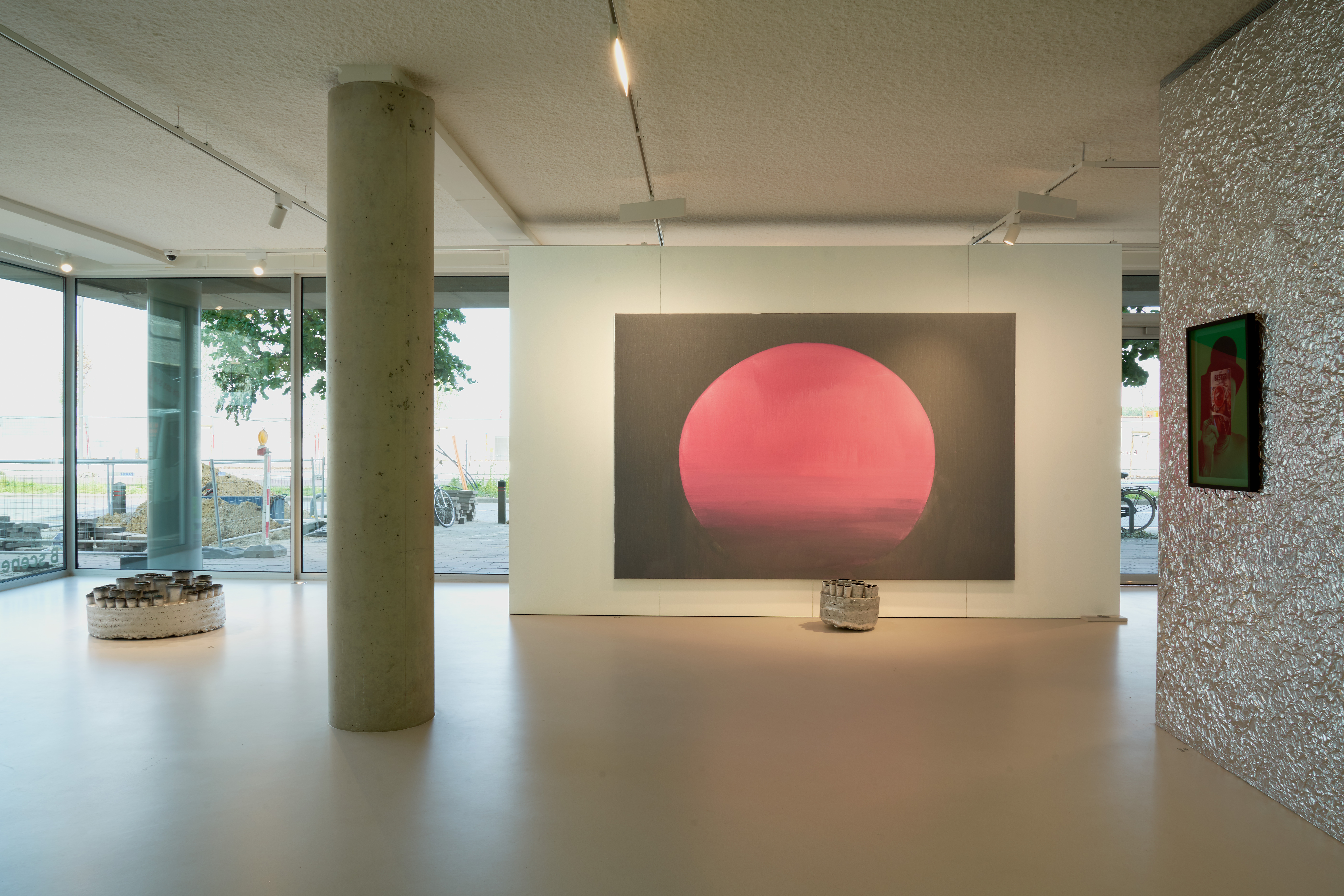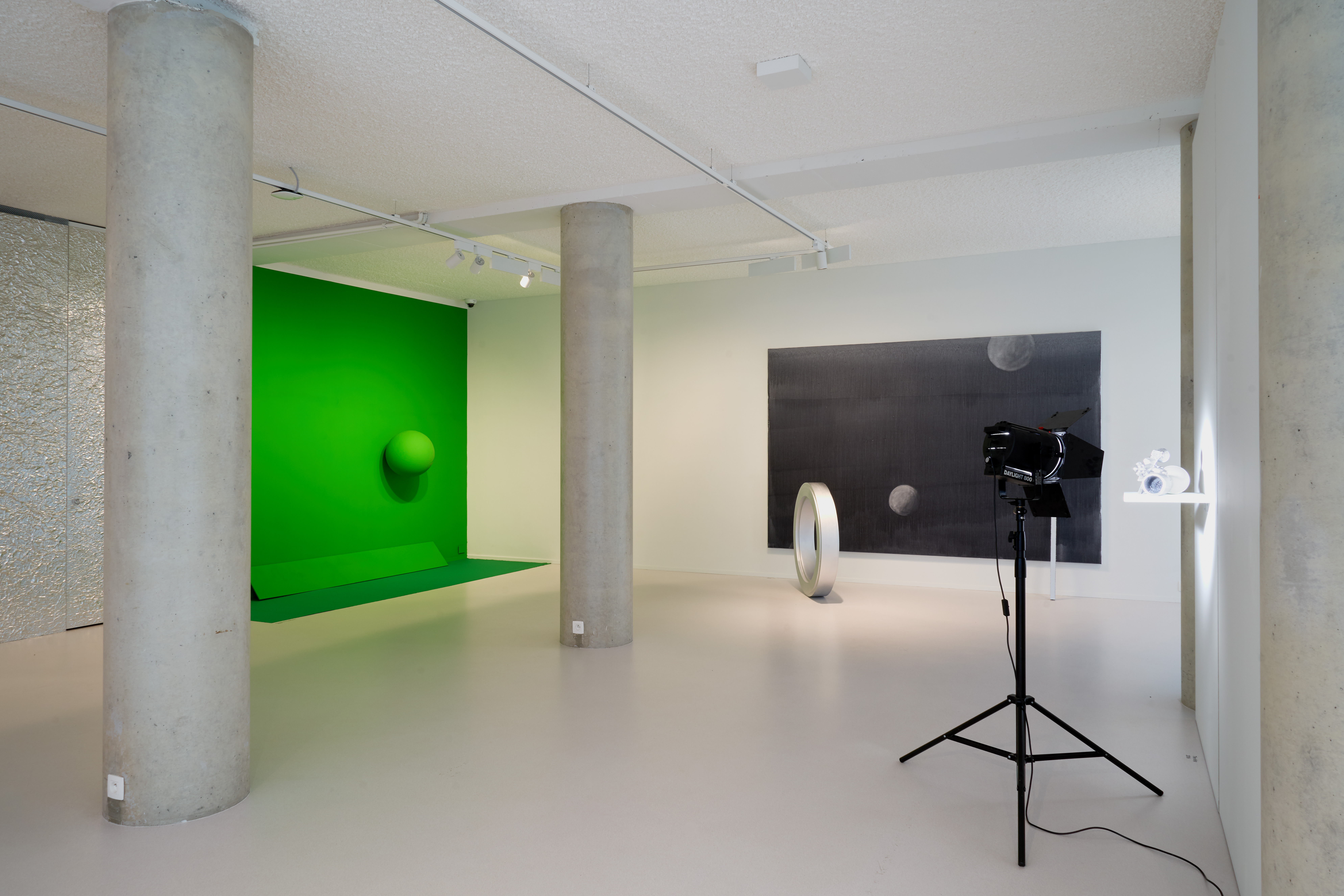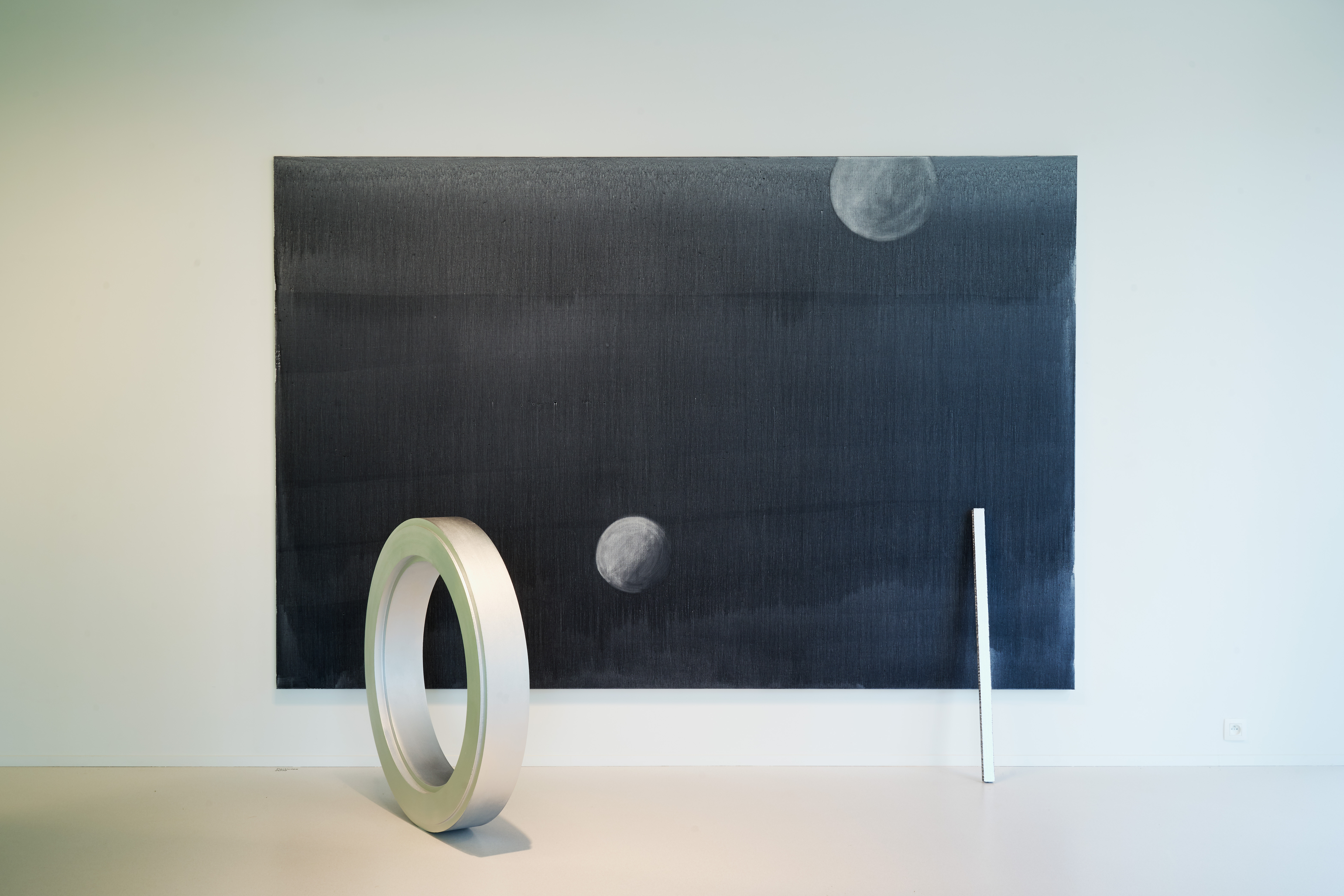
NL
Voor de derde expo in B scene wordt recent werk getoond van Patrick Vanden Eynde (1964), die woont en werkt in Antwerpen en doceert aan de Hogeschool in Hasselt. Onder de titel Cold Fusion brengt hij een tentoonstelling waarin hij het picturale confronteert met 3D-objecten, waarbij de kleur tegelijk een esthetische én functionele rol speelt, en de cinema als blikvanger prominent zijn kunst achtergrond en kracht verleent.
Patrick Vanden Eynde behoort tot een jongere generatie die in het zog van de oudere meester Luc Tuymans (wel) moest zoeken naar persoonlijke artistieke relevantie, die de wereld weliswaar NIET van een direct-beeldende commentaar diende te voorzien. Vanden Eynde en anderen moesten op zoek naar een manier om een parallel universum in een verbeeldende picturale taal te creëren.
Het recente corpus van kunstwerken impliceert een terug- én vooruitblik in de tijd. En door de schilderkunst in een terugkerende beweging te piloteren in een periode waarin zij “functioneel-aankondigend” ten dienste stond van onder andere de cinema met reusachtig geschilderde filmaffiches, slaagt Patrick Vanden Eynde erin zijn onderzoek te reveleren in een zinderende fictie, één die de kunst met de wetenschap (science) verbindt. En dat doet hij als schilder met klasse in combinatie met sf-objecten van karton en PU-schuim, die de notie vervreemding perfect situeren tussen nostalgie en grote onzekerheid over de toekomst. De hedendaagse mens herkent zich wellicht in de toenmalige sciencefiction omdat de realiteit ervan aan de spreekwoordelijke deur staat én dringt. Het filmische wordt nog eens verhevigd door het gebruik van green-key waarin de suggestie van projectie én interpretatie van zijn werk helemaal open blijft en zelfs actief wordt aangemoedigd. Dit project Cold Fusion is te beschouwen als één suite… als één trip én reis “doorheen” beelden die onszelf ontsnappen en om die reden meer dan ooit tot nadenken en verbeelding aansporen. Als de zon aan de ommuurde Schelde ondergaat, wacht de maan om ons mee te nemen in een baan rondom hemellichamen, sf-objecten en sferen die de aardse realiteit al snel als een deel van een pas gelanceerde raket afstoot … “up” to us.
Patrick Vanden Eynde blijft één van onze meest interessante mid-generation kunstenaars/schilders die niet is vast te pinnen op een levenslange herkenbare stijl. Stijl is vandaag een instrument die de relevantie van een kunstwerk niet meer schraagt (weliswaar wel qua houvast en zeker op mercantiel en speculatief kunstmarkt-niveau).
De kunstenaar schreef zelf een verhelderende proeve van tekst als een soort luidop gedeelde denkoefening over een reeks werken die daarom niet allemaal worden opgenomen in de tentoonstelling. En ja, wie beter dan de kunstenaar zelf is “onze” beste gids bij het zien, interpreteren en, waarom ook niet, bij het nuchter ervaren van zijn kunst.
In de iconische slotscène van de film THX1138, de debuutfilm van George Lucas uit 1971 ontsnapt het hoofdpersonage, gespeeld door Robert Duvall, via een luik uit een dystopische, orwelliaanse wereld. Wanneer THX1138 (de naam/nummer van het personage) de bovengrond bereikt, tekent zijn silhouet zich af tegen een beeldvullende oranjekleurige zon. Door de vervlakte scherptediepte laat de zonsondergang, die de climax van de bevrijding symboliseert, het personage haast versmelten met de achtergrond.
Het was deze filmscène die de aanzet gaf tot het gebruik van geschilderde zonnen als achtergrond voor ruimtelijke objecten. Door het motief van de (op- of ondergaande) zon te gebruiken als achtergrond waartegen sculpturale objecten zich aftekenen, verkrijgt hij in deze nieuwe werken een dramatisch, filmisch effect dat ook een verheerlijking van het object veronderstelt.
Het 3D-object met als titel Cold Fusion, meteen ook het titelwerk van deze tentoonstelling, verwijst naar de methode van de koude kernfusie. Deze methode, de “tegenhanger” van hete kernfusie (de energiebron van sterren en dus ook de zon), wordt in sciencefiction vaak aangewend als onuitputtelijke aandrijfkracht voor interstellaire ruimteschepen. Het zou in de toekomst zelfs ons energieprobleem kunnen oplossen, hoewel dat omstreden is. Het zilverkleurige beeld met blauwe gloed doet denken aan een soort toxisch, haast magisch stilleven, maar is een adaptatie van het aandrijfmechanisme van een fictief ruimteschip. Naast de schilderijen van zonnen, bevat de presentatie nog twee schilderijen waarin we zulke ruimtetuigen zien terugkomen. Deze beelden vinden hun oorsprong in ontwerpen van covers van scifi-pocketboeken.
Een ander enigmatisch werk waarin we zulke vormen zien terugkomen is het 3D-object Space Opera uit 2018. De titel verwijst naar het gelijknamige subgenre in de sciencefictionliteratuur. Raadselachtige kleine sculpturale vormen lijken te zweven tegen een groene achtergrond. Het werk is een kartonnen schaalmodel voor een green-key-filmset maar roept ook de associatie op met historische maquettes voor opera- en theaterdecors. De kunstenaar verwijst hier bewust naar de verschuivende rol van schilderkunst in relatie tot andere media. In de begindagen van de filmindustrie was de creatie van achtergronden immers de taak van schilders.
We zien de imaginaire voertuigen ook terugkeren in een aantal andere sculpturale werken in deze tentoonstelling. Vaak zijn dit strakke, geometrische, kristalachtige vormen. In sommige gevallen combineert de kunstenaar dit met gestolde amorfe structuren. Het geheel is meestal afgewerkt met metaalkleurige verf. Het lijken wel artefacten uit een toekomstige wereld.
Het werk biedt ruimte voor uiteenlopende allegorische interpretaties. De elegante choreografie van wonderlijke, alternatieve omgevingskaders en (dystopische) toekomstbeelden uit een recent verleden lijkt een nieuwe dageraad te suggereren. Maar doorheen deze opstelling ademen subtiel verschillende tonen. Hier wordt vaak een dunne grens bewandeld tussen oprechte (nostalgische) fascinatie en milde ironie. De filmische dramatiek helt bijvoorbeeld al eens over naar bewust gearrangeerde, pontificale theatraliteit. In deze nieuwe tentoonstelling Cold Fusion gebeurt dit wellicht nog geraffineerder dan in vroeger werken.
ENG
At the third exhibition in B scene we show work by Patrick Vanden Eynde (b. 1964), who lives and works in Antwerp and teaches at Hasselt College. Under the title Cold Fusion, Vanden Eynde presents an exhibition in which he confronts the pictorial with 3D objects. In this confrontation, colour plays both an aesthetic and functional part, and cinema features prominently to provide background and power for his art.
Vanden Eynde belongs to a younger generation that in the wake of the older master Luc Tuymans (inevitably) had to search for personal artistic relevance, which for that matter did not involve a direct visual comment on the world. What Vanden Eynde and others had to do, was to find a way to create an expressive pictorial language.
The recent body of artworks implies a looking back and ahead in time. By piloting the art of painting back into a period in which it was in a ‘functional-heralding’ way at the service of (among other things) cinema, with huge painted film posters, Vanden Eynde succeeds in revealing his research in a scintillating fiction that links science to art. And as a painter he does an outstanding job, introducing science fiction objects in cardboard and polyurethane foam, which perfectly situate the concept of alienation between nostalgia and great uncertainty about the future. Contemporary people probably recognize themselves in the science fiction of the past because its reality is knocking at the door, impatiently waiting to come in. The cinematic element is reinforced by the use of green key, in which the suggestion of projection and interpretation of the work remains entirely open, and is even encouraged actively. The project Cold Fusion can be considered to be a single suite… a trip and a voyage ‘through’ images that elude us and that for that very reason urge us to think and stimulate the imagination. When the sun sets at the walls of the river Scheldt, the moon is waiting to take us into orbit around celestial bodies, science fiction objects and spheres that before long jettison the earthly reality like one of the stages of a rocket that has just been launched… ‘up’ to us.
Vanden Eynde remains one of the most interesting mid-generation artists/painters who cannot be pinned down to a lifelong recognizable style. Today, style is an instrument that no longer buttresses the relevance of a work of art (though that is still the case to a certain extent, in the sense that it allows to get grip on a work, as well as at the commercial level and with regard to the art market).
The artist himself wrote an enlightening text as a sort of thinking out loud about a series of works, not all of which have for that matter been included in this exhibition. And yes, who better than the artist himself can be ‘our’ guide for looking at, interpreting, and—indeed, why not—objectively experiencing his art.
In the iconic final scene of the film THX1138 (1971), George Lucas’s film debut, the main character (played by Robert Duvall) escapes through a hatch from a dystopian, Orwellian world. When THX1138 (the name/number of the character) reaches the surface of the world above, his silhouette stands out against an orange sun that fills the screen. As the depth of field levels out, the sunset, which characterizes the climax of the liberation, almost causes the protagonist to merge with the background.
It was this scene that inspired Vanden Eynde to use painted suns as the backdrop for three-dimensional objects. By using the motif of the (setting or rising) sun as the backdrop against which sculptural objects stand out, he succeeds in creating in these new works a dramatic cinematic effect, that also presupposes a celebration of the object.
The 3D object entitled Cold Fusion—the work that lent the exhibition its title—refers to the method of cold nuclear fusion. This method, the ‘counterpart’ of hot fusion (the energy source of the stars and thus also of the sun) is often used in science fiction as an inexhaustible energy source for interstellar spaceships. In the future it could even solve our energy problems, though this issue remains controversial. The silver image with its blue glow is reminiscent of a sort of toxic, almost magical still life, but in fact it’s an adaptation of the propulsion mechanism of an imaginary spaceship. Apart from the paintings of suns, there are two paintings on view that feature the return of two of such spacecraft. These images are inspired by the covers of sci-fi novels.
Yet another mysterious work that features similar shapes, is the 3D object Space Opera (2018). The title refers to the subgenre of the same name in science fiction literature. Enigmatic small sculptural shapes seem to hover against a green backdrop. The work is a cardboard scale model for a green-key film set, but also calls forth associations with historical models for opera and theatre sceneries. The artist deliberately refers in this instance to the shifting role of painting with regard to other media. For indeed, in the early days of film, the creation of backdrops was assigned to painters.
The imaginary vehicles also return in a number of other sculptural works in this exhibition. These are often austere, geometrical, crystal-like shapes. In some cases the artist combines these with solidified amorphous structures. The whole is usually finished with metallic paint. The shapes are like artefacts from a future world.
The work allows scope for different allegorical interpretations. The elegant choreography of wondrous, alternative structures and (dystopian) images of the future form a recent past seems to suggest a new dawn. But different shades subtly breathe through the configuration. Here, the artists walks a thin line between genuine (nostalgic) fascination and mild irony. The cinematic drama sometimes tends towards a deliberately arranged majestic theatricality. In the new exhibition Cold Fusion, this happens in an even more sophisticated way than in earlier works.







By Luc Binst and Luk Lambrecht